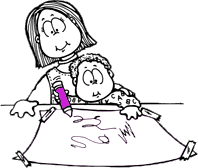 The General Teaching Council for Scotland (GTCS) has their own standards for registration. These are split into two parts, The Standards for Provisional Registration (SPR), and The Standard for Full Registration (SFR). These are a series of standards put in place to make clear how teachers should act, and the values they should possess as a professional. For those of us looking forward to when we apply for Provisional Registration, it is good to use as guidance and support.
The General Teaching Council for Scotland (GTCS) has their own standards for registration. These are split into two parts, The Standards for Provisional Registration (SPR), and The Standard for Full Registration (SFR). These are a series of standards put in place to make clear how teachers should act, and the values they should possess as a professional. For those of us looking forward to when we apply for Provisional Registration, it is good to use as guidance and support.
The SPR lays down what is expected of us as student teachers, and we should use it to shape ourselves into the teachers of the future. It is stated that once you have gained the SPR, and then the SFR, you should continue to develop yourself as a person. These standards are set down to set us up for a “Career of lifelong learning”.
The professional standards we are seeking to attain are vital in shaping us into the best teachers we can be.
It is interesting that the code is essentially the criteria we need to meet to ensure we are fit to  teach. I find it very beneficial that the document States the Professional Values and Personal Commitment that I should have as a teacher. These include:
teach. I find it very beneficial that the document States the Professional Values and Personal Commitment that I should have as a teacher. These include:
- Social Justice
- Integrity
- Trust and Respect
- Professional Commitment
I like how it goes into great depth about which areas we should be knowledgeable about, such as the curriculum, teaching programmes and assessments. It is very helpful that it has a breakdown of the things within education policy (such as laws and legislations), as well as the education system we should be aware of as students.
The standards do however state that we should have high expectations of all learners (3.1.4). Whereas I do feel our expectations should be relatively high, is it not unrealistic to have high expectations of everyone? Not everyone has the same abilities, and expectations should be specific to each individual learner.
Within a separate document, The Student Teacher Code, there are different rules laid down. I didn’t realise that after we gain the SFR, as well as having our PVG’s and by that time tonnes of experience in the classroom, the GTC STILL assess our fitness to teach. I do however understand the seriousness of a criminal conviction, and agree with GTC’s need to investigate any allegations.
 I found the “Key Principles of the Student Teacher Code” Very helpful. They state that as a student we should be good role models, make our pupils our main focus, and be respectful of others along with a few others.
I found the “Key Principles of the Student Teacher Code” Very helpful. They state that as a student we should be good role models, make our pupils our main focus, and be respectful of others along with a few others.
When we are working with pupils we should show good moral values. Part 1 of the code is about how we work with pupils. It contains points about us having to keep sensitive information confidential, and that we should be a role model in EVERYTHING we do and say. I like the way they have written this into an easy to read document.
Part 2 is about how us as a student teacher works with others. As I took the Working Together module for my elective, it is nice to see the=is document including the importance of working cooperatively with those in other professions. I also think it is fair that it states you should not comment on other teachers or professionals within the educational community. I can only imagine the damage this could cause and I would not wish it on anyone.
Part 3 is mainly about how we should be honest and show integrity as a student teacher. Whilst
reading this part of the comment, it is very evident that a lot of these points. No matter what profession I could have chosen to go into I would never engage in criminal behaviour. I also find it very upsetting that some serious offences must have taken place in the past for some of these points to be added to this document. The point on social networking stands out a lot. I agree as professionals we should definitely be careful of how we portray ourselves on social media. We do not want our reputation ruined.
Overall, the whole Student-Teacher Code is beneficial in highlighting how we should and should not act as professionals. The importance of equality and diversity are extremely important, especially when considering the Equality Act (2010). I can see how this code coincides with the standards for provisional education, which are both very useful documents.













![DRRES]](https://glow-prod-glowblogs.s3.eu-west-1.amazonaws.com/glowblogs/public/laurenseportfolio/uploads/sites/2978/2015/10/DRRES-253x300.png?X-Amz-Content-Sha256=UNSIGNED-PAYLOAD&X-Amz-Security-Token=IQoJb3JpZ2luX2VjEAQaCWV1LXdlc3QtMSJHMEUCICWt0vHDEyR6XZpJ%2BzxiAZKI0Quz%2FNpPJIPbc9Ay56fwAiEA3nJSrgw3Y1GFXmP%2BeNmxZjsXRyuMcAlnfnwCsYwAx%2BIqwgUIzf%2F%2F%2F%2F%2F%2F%2F%2F%2F%2FARAFGgwyNzM1NzAxOTU0MzMiDO07lRQm2sU4fGjj4iqWBaS2ZzDRLeS3uayrOve13kzk0UkRO%2BphyY5oa3OQa61qkmwSNNwnFyRn3z1xEIb8uez2EcIe%2BZCrEQMQzsEWSno2Vf%2BtaXxADSz3B254B9VG6vQuYlM65Bo8V39SGs%2FevWAielg6eUvH52hendjES3npnl5SSk5vEdrqmYKFKZfrthHah9RoFwwVCd4%2F3SIJxgfkhqwnl3OQIV7RvwjgzTMg4of8lXdFNeSNFbRPzaLpHIvJhoNxMeL%2FrafJ%2FOnBkNX2%2BaO8iMsZKmkQ1UztyRpaZA%2BnSMP3dPQ%2Bc1jWGFGfpeDuZNJXtdL4FeoGyxly84zXVbBgRlelpSY5mKuryEgTqSJuXiQF1EZcovmIOHrxOTMvB9uxSY5eIrpBzunySzgKpxtYVyBxhALY6vp0acImHwPrV1qUEOsiJNohIk2AIVjFoNc8zX3QqjCcwf0dB2rTxZqrpZfEiAmlyBnMWmWuRJ6i5OxbmTuJcQIkBQGo07v33IpeN7KZBZ5jfTJm491VwMiCmECqQ%2FexcX1AcNmPcjYFxAdliBb3pRA9JJ%2B4eVcdn4Ua2BrPM2bwh6jd2l4NcX%2Bc2hUWoFwEJA2ORrg3Olsi%2FueFHe3YA2d0vZ0ZoseP5S7FV2VjcPsNT824XNrDC%2FbZU%2F6bQ96s%2F03O4g8v4cass7WROweOsBnnX0iZcSI09UskT1f3relT9NNWkmnsMCpnqmrE99w8ChXPh%2FWAhUBj0YW93fcJ3bBSAjG0XzfDQ58EYPXFEJw6d6cCGckRcjZmJJW7mS5%2FHS99IiYi9Jhag9GpDWNf7XOI%2BUV4UB6ZJXm0pfIKEj2YVMHt6G0artU4k21MrL0sCM7ZSjmKM2DolKE4CXp9%2F%2F5cikTjmV7IjYYBMMW%2Bo7sGOrEBr7Lmp4ZfNREp%2F0t93JdSwnOH26TeuGU6Rab7op%2FypJwYIrF3UuXLIVkE7ravipb8zm3LDkNYsH4GOqhNk9sd7OrFlYiQaeAjpqZOnZde%2FXWoU6vLwBMI5Cyc8YvR5u2rjeO7rxozs8atTYHA7vuPJJdj7SilRZiQJ2dZIRGt1N%2Fs0C1lqon7H%2BLwRtXh53ysmw6EprOFPRHa8RP9UMZM%2FvkkrlpoTm3NU%2BTJ0snMvcVN&X-Amz-Algorithm=AWS4-HMAC-SHA256&X-Amz-Credential=ASIAT7MQN47UYFIQCOXH%2F20241223%2Feu-west-1%2Fs3%2Faws4_request&X-Amz-Date=20241223T040357Z&X-Amz-SignedHeaders=host&X-Amz-Expires=900&X-Amz-Signature=13a8cc69d854df79f60b28b1961a59010e642a35ed6a6aeb4dc784ca0ce226dd)




